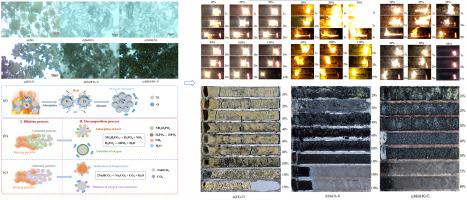三种抑制剂对钛粉尘层火焰传播的抑制特性
IF 4.5
2区 工程技术
Q2 ENGINEERING, CHEMICAL
引用次数: 0
摘要
在自制的实验系统中研究了三种抑制剂(TiO2、NaHCO3 和 NH4H2PO4)对钛粉尘层火焰传播的抑制作用。使用照相机和红外图像记录抑制剂对钛粉/抑制剂火焰传播过程的影响。分析了三种抑制剂/钛粉的燃烧产物,以了解抑制剂的抑制机理。研究了三种抑制剂对钛粉着火诱导时间的影响。在高温条件下,NaHCO3 和 NH4H2PO4 的分解过程以及气体的产生可能是加速火焰传播的主要原因。粉尘层中的多个高温区域会加速火焰的传播速度。详细解释了三种抑制剂的抑制机理。TiO2 的抑制机理主要在于其较强的热稳定性。NaHCO3 和 NH4H2PO4 的抑制作用包括稀释过程和分解过程。本文章由计算机程序翻译,如有差异,请以英文原文为准。

Suppression characteristic of three inhibitors on the flame propagation of titanium dust layer
The suppression effect of three inhibitors (TiO2, NaHCO3, and NH4H2PO4) on the flame propagation of titanium dust layer is investigated in the self-made experimental system. Both camera and infrared images are used to record the effect of the inhibitor on the flame propagation process of titanium/inhibitors powder. The combustion products of three inhibitor/Ti dusts are analyzed to suppression mechanism of inhibitors. The effect of three inhibitors on the ignition induction time of the titanium powder is studied. The decomposition process of NaHCO3 and NH4H2PO4 and the production of gas under high temperature conditions may be the main reason for accelerating the flame propagation. The multiple high temperature regions in the dust layer can accelerate the flame propagation rate. Suppression mechanisms of three inhibitors are explained in detail. The inhibition mechanism of TiO2 mainly lies in its strong thermal stability. The inhibition effects of NaHCO3 and NH4H2PO4 include the dilution process and the decomposition process.
求助全文
通过发布文献求助,成功后即可免费获取论文全文。
去求助
来源期刊

Powder Technology
工程技术-工程:化工
CiteScore
9.90
自引率
15.40%
发文量
1047
审稿时长
46 days
期刊介绍:
Powder Technology is an International Journal on the Science and Technology of Wet and Dry Particulate Systems. Powder Technology publishes papers on all aspects of the formation of particles and their characterisation and on the study of systems containing particulate solids. No limitation is imposed on the size of the particles, which may range from nanometre scale, as in pigments or aerosols, to that of mined or quarried materials. The following list of topics is not intended to be comprehensive, but rather to indicate typical subjects which fall within the scope of the journal's interests:
Formation and synthesis of particles by precipitation and other methods.
Modification of particles by agglomeration, coating, comminution and attrition.
Characterisation of the size, shape, surface area, pore structure and strength of particles and agglomerates (including the origins and effects of inter particle forces).
Packing, failure, flow and permeability of assemblies of particles.
Particle-particle interactions and suspension rheology.
Handling and processing operations such as slurry flow, fluidization, pneumatic conveying.
Interactions between particles and their environment, including delivery of particulate products to the body.
Applications of particle technology in production of pharmaceuticals, chemicals, foods, pigments, structural, and functional materials and in environmental and energy related matters.
For materials-oriented contributions we are looking for articles revealing the effect of particle/powder characteristics (size, morphology and composition, in that order) on material performance or functionality and, ideally, comparison to any industrial standard.
 求助内容:
求助内容: 应助结果提醒方式:
应助结果提醒方式:


